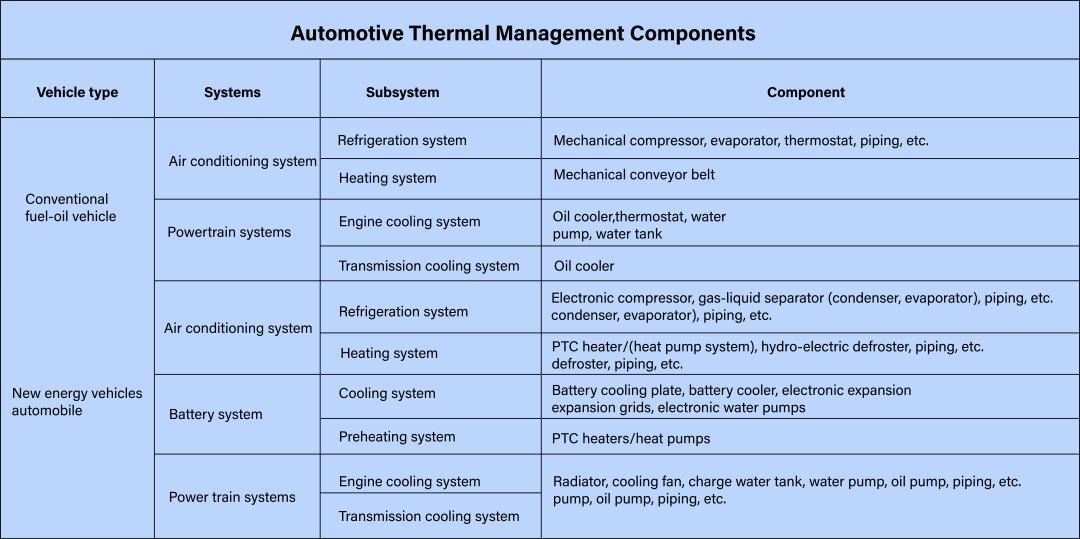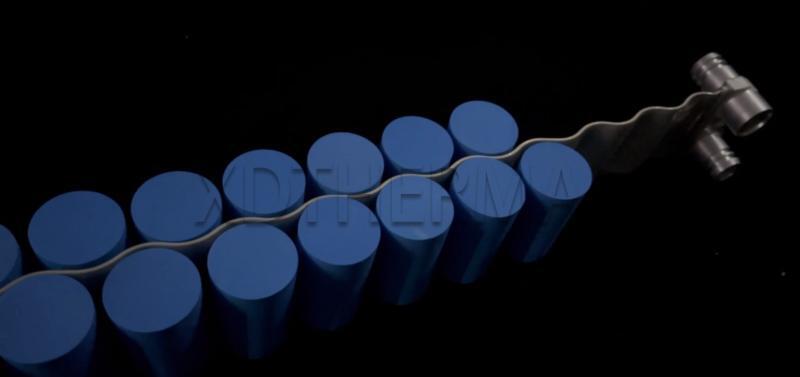La transición de los vehículos de combustible tradicionales a los modernos vehículos de nuevas energías ha repercutido significativamente en la complejidad de los sistemas de gestión térmica de los vehículos. Originalmente sencillos, estos sistemas han evolucionado hasta convertirse en estructuras intrincadas, pasando de módulos independientes a la ingeniería de sistemas integrados.
La gestión térmica tradicional afecta principalmente al aire acondicionado y a los sistemas de propulsión. En cambio, los nuevos vehículos energéticos incorporan el sistema de baterías al ámbito de la gestión térmica, lo que supone un cambio hacia una "nueva" gestión térmica.
Este artículo se centra en los componentes clave de los sistemas de gestión térmica tradicionales y nuevos. En los sistemas tradicionales, destacamos el condensador, el evaporador, el radiador, el enfriador de aceite y el intercooler. En el caso de la nueva gestión térmica, la atención se centra en el placa de refrigeración de la batería.

El condensador es un componente integral del circuito de refrigerante del aire acondicionado (A/C) del vehículo. Se conecta al compresor de aire acondicionado y al secador-receptor a través de tuberías de cobre y aluminio. Normalmente se instala delante del radiador del coche y suele compartir un ventilador de refrigeración con el radiador. En función del tipo de refrigerante utilizado, los condensadores pueden clasificarse en cuatro tipos: refrigerados por agua, refrigerados por aire, refrigerados por agua y aire (incluidos los tipos evaporativos y de pulverización), y los refrigerados por evaporación del refrigerante u otros medios de proceso.
Durante el funcionamiento, el condensador enfría el refrigerante de alta presión y alta temperatura hasta convertirlo en un líquido de alta presión y baja temperatura. A continuación, este líquido pasa a través de un tubo capilar, vaporizándose en el evaporador para continuar el ciclo de refrigeración. Como este proceso libera calor, el condensador suele funcionar a alta temperatura, lo que lo clasifica como un tipo de intercambiador de calor.
A la inversa, el evaporador, situado detrás del filtro de aire del habitáculo, absorbe calor, lo que provoca un descenso de la temperatura superficial. Cuando el ventilador del vehículo sopla aire sobre el evaporador, el aire se enfría, generando aire frío para proporcionar un ambiente confortable en el interior del coche.
Ventajas:
Libera rápidamente el calor del refrigerante al ambiente exterior.
Mejora la eficiencia del sistema de aire acondicionado.
Fabricados con materiales de aluminio o cobre resistentes a altas temperaturas.
El mantenimiento y la limpieza son relativamente sencillos.
Ayuda a mantener una temperatura agradable en el interior del vehículo.
Desventajas:
Se daña fácilmente con los restos de la carretera o los impactos.
Necesita una limpieza regular para mantener su eficacia.
La suciedad afecta a la eficacia de la refrigeración.
El rendimiento se reduce a temperaturas muy altas o muy bajas.
La instalación o sustitución puede ser complicada.
El radiador es un componente crucial del motor, compuesto principalmente por el núcleo del radiador, las tuberías de agua, el ventilador de refrigeración, el depósito superior y el depósito inferior, todos ellos conectados por mangueras de goma. El depósito superior está conectado al radiador inferior mediante tuberías de agua. El agua caliente fluye del depósito superior al inferior, enfriándose a medida que desciende. El ventilador de refrigeración, impulsado por la succión del ventilador y el movimiento de avance del coche, crea conductos por los que circula el aire frío, garantizando una regulación eficaz de la temperatura.
Este tipo de radiador es esencial para refrigerar los motores de combustión interna. Dado que los motores pueden realizar hasta aproximadamente 4.000 ciclos de combustión de gasolina por minuto, cada uno de los cuales genera temperaturas de hasta unos 1.500 °C, es necesario un intercambiador de calor para mantener un control estricto de la temperatura del motor.
Ventajas:
Absorbe y disipa el calor del motor para evitar el sobrecalentamiento y mantener temperaturas óptimas.
Regula la temperatura del motor para un rendimiento constante, una mayor potencia y una vida útil más larga.
Equipado con tapones de presión para evitar la ebullición del refrigerante y garantizar una refrigeración estable.
Funciona con varios refrigerantes, incluido el anticongelante, para ayudar en la transferencia de calor y evitar la congelación.
Fabricado con materiales resistentes a la corrosión, que prolongan la vida útil del sistema y reducen el mantenimiento.
Económicos y duraderos, reducen los costes generales de mantenimiento del vehículo.
Desventajas:
Requiere la sustitución periódica del refrigerante y revisiones del sistema, lo que puede resultar costoso e incómodo.
Propenso a las fugas, lo que puede provocar la pérdida de refrigerante y el sobrecalentamiento del motor.
Voluminoso y pesado, problemático en aplicaciones con limitaciones de espacio o sensibles al peso.
Puede sufrir electrólisis, lo que acelera la corrosión y los daños.
Los materiales se degradan con el tiempo, lo que reduce su rendimiento y provoca posibles fallos.
Tiene límites de temperatura; las condiciones extremas pueden afectar a su eficacia y durabilidad.
No todos los tipos de refrigerante son adecuados, y su uso incorrecto puede afectar al rendimiento y la longevidad.
El radiador de aceite, al igual que el radiador, forma parte del sistema de refrigeración del motor y se utiliza principalmente para refrigerar el aceite lubricante o el combustible en vehículos, maquinaria de construcción, barcos y otros motores. Dado que el aceite del motor tiene conductividad térmica y circula continuamente dentro del motor, el radiador de aceite desempeña un papel crucial en la refrigeración de componentes como el cárter, el embrague y el conjunto de válvulas.
Incluso en los motores refrigerados por agua, sólo la culata y la pared del cilindro pueden refrigerarse con agua, mientras que las demás piezas dependen del refrigerador de aceite. Los principales materiales de los radiadores de aceite son el aluminio, el cobre, el acero inoxidable y el metal fundido, que se sueldan o ensamblan para crear un intercambiador de calor completo conectando los canales de los lados caliente y frío.
Durante el funcionamiento del vehículo, el aceite lubricante procedente de varios sistemas de lubricación, impulsado por la bomba de aceite, pasa a través del canal del lado caliente del enfriador de aceite, transfiriendo calor al lado frío. A continuación, el agua o el aire de refrigeración circulan por el canal del lado frío del refrigerador de aceite, eliminando el calor y facilitando el intercambio térmico entre los fluidos caliente y frío. Este proceso garantiza que el aceite lubricante se mantenga a la temperatura óptima de trabajo. Es importante destacar que el aceite y el medio refrigerante no entran en contacto directo durante este proceso.
Tanto los motores sobrealimentados como los turboalimentados requieren un intercambiador de calor conocido como intercooler, situado entre el cargador y el colector de admisión del motor. Cuando un turbocompresor comprime el aire, su temperatura y densidad aumentan considerablemente. El intercooler sirve para enfriar este aire a alta temperatura antes de que entre en el motor.
Sin un intercooler, el aire a alta temperatura procedente del turbocompresor entraría directamente en el motor, pudiendo causar daños en el motor o incluso averías debido a las excesivas temperaturas del aire. Por lo tanto, el intercooler es crucial para mantener un rendimiento óptimo del motor y evitar el sobrecalentamiento. Por lo general, este componente sólo está presente en los vehículos equipados con turbocompresor.
En el campo de la tecnología de gestión térmica, en constante evolución, destacan las placas de refrigeración líquida. A diferencia de los disipadores convencionales, ofrecen una gestión térmica más eficiente de la batería no del motor ni del refrigerante, lo que las hace ideales para entornos de alto rendimiento como vehículos eléctricos, sistemas informáticos avanzados y maquinaria industrial.
El exceso de calor generado por la batería se transfiere a través del contacto con la superficie de una placa de aluminio. El sistema de refrigeración líquida utiliza el alto coeficiente de transferencia térmica del flujo de líquido para transferir el calor de forma eficaz. El refrigerante fluye por los canales internos, absorbiendo y transportando el calor.

El embalaje de las pilas de litio -cuadradas, cilíndricas y blandas- afecta al rendimiento, la eficiencia y la seguridad. Las baterías cuadradas ofrecen una alta eficiencia, pero se enfrentan a problemas de disipación del calor. Las cilíndricas ofrecen buena disipación del calor y consistencia, pero su densidad energética es menor. Las baterías blandas son flexibles y de alta densidad energética, pero más caras.
La gestión eficaz del calor es crucial. Los avances incluyen materiales de cambio de fase con refrigeración líquida, diseños de aire optimizados y métodos de refrigeración híbridos, que mejoran el rendimiento y la seguridad en todos los tipos de baterías.

He trabajado en la gestión térmica de baterías durante más de 5 años, ocupándome de muchos proyectos internacionales. Si tiene curiosidad sobre los productos o servicios de refrigeración líquida de baterías, ¡no dude en hacerme cualquier pregunta!